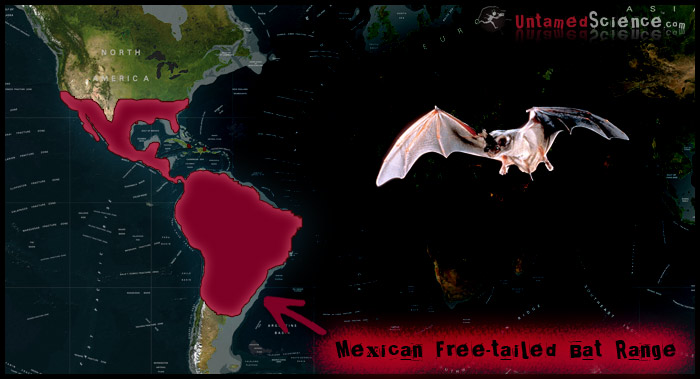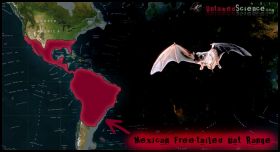Mexican Free-tailed Bat
Tadarida brasiliensis
A Tiny Bat in a Big City
The Mexican Free-tailed Bat (Tadarida brasiliensis) is also known as the Brazilian Free-tailed bat. It is one of the most abundant free-tailed bats in the world and one of the most abundant mammals in North America. In places like south Texas, the free-tailed bat roosts in large colonies during the summer months.
One roosting spot is located in the urban setting of Austin, Texas, underneath the Congress Street Bridge, south of downtown. Every night 700,000 to 1.5 million bats (depending on how many baby bats have been born in the season) emerge to feed on flying insects in the night sky. The bats in Austin are a spectacle that tourists have flocked to see since the bridge construction was made “bat-friendly” in 1980. Interestingly enough, this was done completely by accident. Small 1.5 inch slats on the bridge’s concrete extend 20 inches into the bridge. This hiding space proved to be an ideal roosting spot for Mexican free-tailed bats. Today other bridges in Texas are being fitted with similar slats to allow for the habitation of bats.
What is the range of these bats?
The Mexican free-tailed bat has a range that extends from coast to coast in the US and from Texas to Argentina. In the US, the bats migrate south in the winter and return to roosting sites in the summer. It is still unknown where the bats go in the winter months.
How long do they live?
Mexican free-tailed bats live for an estimated seven to eight years. Once born it takes a couple years before they start breeding. Mature females will give birth to one pup each year for about five years.
What do Mexican free-tailed bats eat?
These small bats eat primarily flying insects. They can eat three times their body weight each night while foraging.
Related Topics
A Tiny Bat in a Big City
The Mexican Free-tailed Bat (Tadarida brasiliensis) is also known as the Brazilian Free-tailed bat. It is one of the most abundant free-tailed bats in the world and one of the most abundant mammals in North America. In places like south Texas, the free-tailed bat roosts in large colonies during the summer months.
One roosting spot is located in the urban setting of Austin, Texas, underneath the Congress Street Bridge, south of downtown. Every night 700,000 to 1.5 million bats (depending on how many baby bats have been born in the season) emerge to feed on flying insects in the night sky. The bats in Austin are a spectacle that tourists have flocked to see since the bridge construction was made “bat-friendly” in 1980. Interestingly enough, this was done completely by accident. Small 1.5 inch slats on the bridge’s concrete extend 20 inches into the bridge. This hiding space proved to be an ideal roosting spot for Mexican free-tailed bats. Today other bridges in Texas are being fitted with similar slats to allow for the habitation of bats.
What is the range of these bats?
The Mexican free-tailed bat has a range that extends from coast to coast in the US and from Texas to Argentina. In the US, the bats migrate south in the winter and return to roosting sites in the summer. It is still unknown where the bats go in the winter months.
How long do they live?
Mexican free-tailed bats live for an estimated seven to eight years. Once born it takes a couple years before they start breeding. Mature females will give birth to one pup each year for about five years.
What do Mexican free-tailed bats eat?
These small bats eat primarily flying insects. They can eat three times their body weight each night while foraging.


































































































